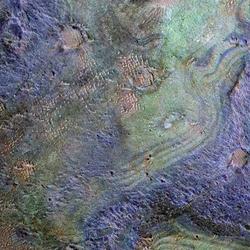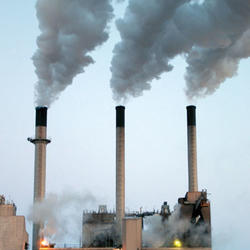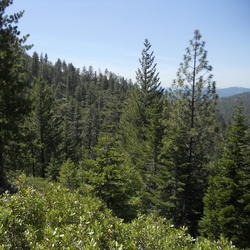UAS operations near Moab, Utah for carbon sequestration research on public lands
What is carbon sequestration?
Carbon dioxide is the most commonly produced greenhouse gas. Carbon sequestration is the process of capturing and storing atmospheric carbon dioxide. It is one method of reducing the amount of carbon dioxide in the atmosphere with the goal of reducing global climate change. The USGS is conducting assessments on two major types of carbon sequestration: geologic and biologic.
Related
What’s the difference between geologic and biologic carbon sequestration?
How does carbon get into the atmosphere?
How much carbon dioxide can the United States store via geologic sequestration?
Which area is the best for geologic carbon sequestration?
How much carbon dioxide does the United States and the World emit each year from energy sources?
Has the USGS made any Biologic Carbon Sequestration assessments?

UAS operations near Moab, Utah for carbon sequestration research on public lands
Biological carbon sequestration is the natural ability of life and ecosystems to store carbon. Forests, peat marshes, and coastal wetlands are particularly good as storing carbon. Carbon can be stored in plant tissue, such as long-lived tree bark or in extensive root systems. Microbes break down plant and animal tissue through decomposition.
Biological carbon sequestration is the natural ability of life and ecosystems to store carbon. Forests, peat marshes, and coastal wetlands are particularly good as storing carbon. Carbon can be stored in plant tissue, such as long-lived tree bark or in extensive root systems. Microbes break down plant and animal tissue through decomposition.
A short video on how carbon can get into the atmosphere.
A short video on how carbon can get into the atmosphere.

This auger is used to collect 1 meter deep soil cores for a carbon budget study associated with the SageSTEP project. SageSTEP is a long-term, multi-disciplinary experiment evaluating sagebrush restoration methods in the Great Basin.
This auger is used to collect 1 meter deep soil cores for a carbon budget study associated with the SageSTEP project. SageSTEP is a long-term, multi-disciplinary experiment evaluating sagebrush restoration methods in the Great Basin.
The use of carbon dioxide (CO2) injection for enhanced oil recovery (EOR) can prolong the productivity of many oil reservoirs and increase the U.S. hydrocarbon recoverable resource volume.
The use of carbon dioxide (CO2) injection for enhanced oil recovery (EOR) can prolong the productivity of many oil reservoirs and increase the U.S. hydrocarbon recoverable resource volume.
 PubTalk 1/2011 — Capture and Geologic Sequestration of Carbon Dioxide
PubTalk 1/2011 — Capture and Geologic Sequestration of Carbon Dioxide
Is Sequestration Necessary? Can We Do It at an Acceptable Total Cost?
By Yousif Kharaka, USGS National Research Program
Is Sequestration Necessary? Can We Do It at an Acceptable Total Cost?
By Yousif Kharaka, USGS National Research Program
A new method to assess the Nation's potential for storing carbon dioxide in rocks below the earth's surface could help lessen climate change impacts. The injection and storage of liquid carbon dioxide into subsurface rocks is known as geologic carbon sequestration.
Federal lands greenhouse gas emissions and sequestration in the United States: Estimates for 2005–22
National assessment of carbon dioxide enhanced oil recovery and associated carbon dioxide retention resources — Summary
National assessment of carbon dioxide enhanced oil recovery and associated carbon dioxide retention resources — Results
Carbon dioxide mineralization feasibility in the United States
Federal lands greenhouse emissions and sequestration in the United States—Estimates for 2005–14
A long-term comparison of carbon sequestration rates in impounded and naturally tidal freshwater marshes along the lower Waccamaw River, South Carolina
Aggregation of carbon dioxide sequestration storage assessment units
Biochar for soil fertility and natural carbon sequestration
A feasibility study of geological CO2 sequestration in the Ordos Basin, China
A method for assessing carbon stocks, carbon sequestration, and greenhouse-gas fluxes in ecosystems of the United States under present conditions and future scenarios
A national look at carbon capture and storage-National carbon sequestration database and geographical information system (NatCarb)
Carbon sequestration and its role in the global carbon cycle
Related
What’s the difference between geologic and biologic carbon sequestration?
How does carbon get into the atmosphere?
How much carbon dioxide can the United States store via geologic sequestration?
Which area is the best for geologic carbon sequestration?
How much carbon dioxide does the United States and the World emit each year from energy sources?
Has the USGS made any Biologic Carbon Sequestration assessments?

UAS operations near Moab, Utah for carbon sequestration research on public lands
UAS operations near Moab, Utah for carbon sequestration research on public lands
Biological carbon sequestration is the natural ability of life and ecosystems to store carbon. Forests, peat marshes, and coastal wetlands are particularly good as storing carbon. Carbon can be stored in plant tissue, such as long-lived tree bark or in extensive root systems. Microbes break down plant and animal tissue through decomposition.
Biological carbon sequestration is the natural ability of life and ecosystems to store carbon. Forests, peat marshes, and coastal wetlands are particularly good as storing carbon. Carbon can be stored in plant tissue, such as long-lived tree bark or in extensive root systems. Microbes break down plant and animal tissue through decomposition.
A short video on how carbon can get into the atmosphere.
A short video on how carbon can get into the atmosphere.

This auger is used to collect 1 meter deep soil cores for a carbon budget study associated with the SageSTEP project. SageSTEP is a long-term, multi-disciplinary experiment evaluating sagebrush restoration methods in the Great Basin.
This auger is used to collect 1 meter deep soil cores for a carbon budget study associated with the SageSTEP project. SageSTEP is a long-term, multi-disciplinary experiment evaluating sagebrush restoration methods in the Great Basin.
The use of carbon dioxide (CO2) injection for enhanced oil recovery (EOR) can prolong the productivity of many oil reservoirs and increase the U.S. hydrocarbon recoverable resource volume.
The use of carbon dioxide (CO2) injection for enhanced oil recovery (EOR) can prolong the productivity of many oil reservoirs and increase the U.S. hydrocarbon recoverable resource volume.
 PubTalk 1/2011 — Capture and Geologic Sequestration of Carbon Dioxide
PubTalk 1/2011 — Capture and Geologic Sequestration of Carbon Dioxide
Is Sequestration Necessary? Can We Do It at an Acceptable Total Cost?
By Yousif Kharaka, USGS National Research Program
Is Sequestration Necessary? Can We Do It at an Acceptable Total Cost?
By Yousif Kharaka, USGS National Research Program
A new method to assess the Nation's potential for storing carbon dioxide in rocks below the earth's surface could help lessen climate change impacts. The injection and storage of liquid carbon dioxide into subsurface rocks is known as geologic carbon sequestration.











